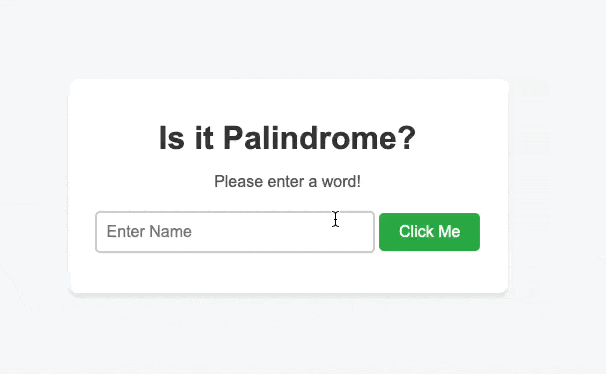In this project, I ventured into the world of backend development to create a simple Node.js application that checks if a given string is a palindrome. A palindrome is a word, phrase, or sequence of characters that reads the same forward as backward (ignoring spaces, punctuation, and capitalization).
- Node.js and HTTP Server: I learned how to set up a basic HTTP server using Node.js and handle different HTTP requests.
- Server-Side Logic: Implementing the palindrome logic on the server side was a key learning point. This approach ensures that the logic is secure and cannot be tampered with by the end-users.
- Parsing URL and Query Strings: I got hands-on experience with parsing URLs and query strings to extract parameters from the HTTP requests.
- Sending JSON Responses: I learned how to send JSON responses back to the client and handle different HTTP status codes.
- Handling Static Files: I figured out how to serve static files like HTML, CSS, and JavaScript from the server.
The main components of the project include:
server.js: This is the heart of the application where the server is set up, and different HTTP requests are handled.index.html: The main HTML file that provides a user interface for inputting strings and displaying results.css/style.css: A simple CSS file to add some styling to the web page.js/main.js: The frontend JavaScript that interacts with the backend API.
- First, make sure you have Node.js installed on your computer.
- Download or clone the project files to your local machine.
- Open a terminal and navigate to the project's directory.
- Run
npm installto install the required dependencies. - Start the server with
node server.js. - Open your browser and visit
http://localhost:8000. - Enter a string in the input box and click the "Check" button to see if it's a palindrome.
Here is a simplified explanation of how the server handles palindrome checks:
function isPalindrome(str) {
let copy = str.toLowerCase().split("").reverse().join("");
return str.toLowerCase() === copy; // true or false
}
else if (page == "/api") {
if ("palindrome" in params) {
const word = params["palindrome"];
if (word !== "") {
const isWordPalindrome = isPalindrome(word);
res.writeHead(200, { "Content-Type": "application/json" });
res.end(JSON.stringify({ result: isWordPalindrome }));
} else {
res.writeHead(400, { "Content-Type": "application/json" });
res.end(JSON.stringify({ error: "Please enter a word to check." }));
}
}
}In this part of the code, when a request comes to the /api endpoint, the server checks if there is a palindrome parameter in the query string. If the parameter is there and not an empty string, the server runs the isPalindrome function to check if the word is a palindrome and sends the result back as a JSON object. If the parameter is missing or an empty string, the server responds with an error message, guiding the user to enter a word.
Below is a gif demonstrating how the project works. You can see how the user inputs a word, clicks the "Check" button, and immediately receives feedback on whether the word is a palindrome or not.
This project was a fantastic opportunity for me to dive into backend development, learn about server-side logic, and understand how to interact with APIs. I now feel more confident in my abilities to create backend functionalities and look forward to applying these learnings in future projects.
